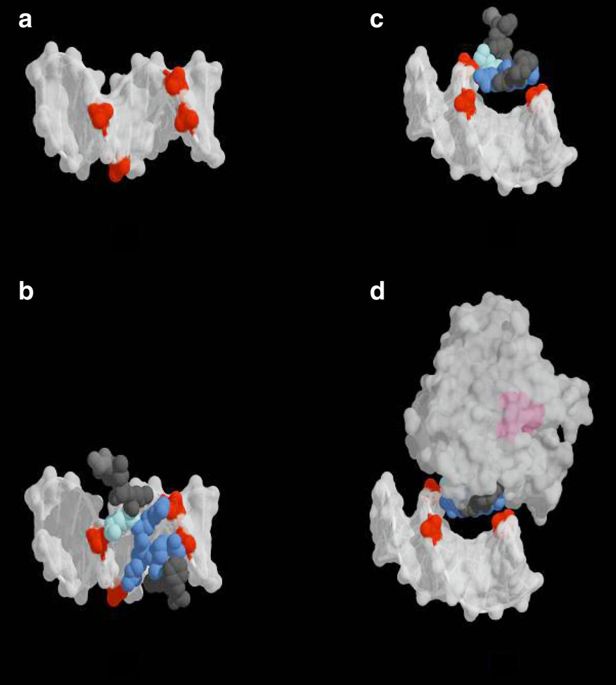Current Research Areas
The Blainey lab addresses major challenges in single cell genomic and functional analysis, drug screening, and genomic screening by combining diverse molecular, optical, and microfluidic technologies. Many of our experimental efforts efficiently produce large multiparameter datasets from key biological models and primary human material that match well with advanced analytical methods.
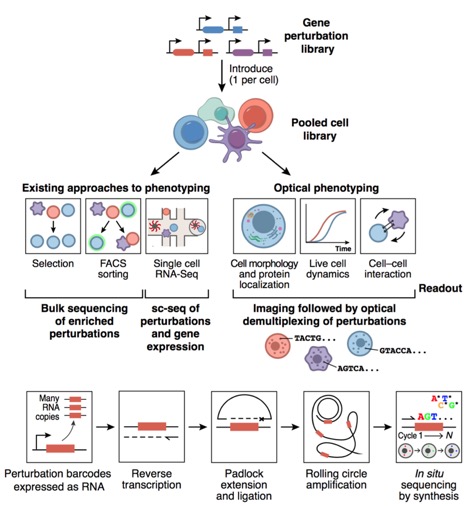
Pooled optical genetic screening in human cells
The group is applying targeted in situ sequencing to determine the thousands of CRISPR perturbations in millions of cells by imaging, naturally linking large perturbation sets with rich image-based cellular phenotypes in powerful pooled formats. This capability reduces the cost for spatially and temporally-resolved screens by multiple orders of magnitude and extends large-scale pooled screening into new biological models and disease areas.
Key publications and resources:
- Feldman, Singh et al., Optical pooled screens in human cells (2019), Cell.
- Feldman, Funk et al., Pooled genetic perturbation screens with image-based phenotypes (2022), Nature Protocols.
- Walton et al., Pooled genetic screens with image-based profiling (2022), Review, Molecular Systems Biology.
- Funk, Su et al., The phenotypic landscape of essential human genes (2022), Cell.
- Vesuvius web portal (accompanies Funk, Su et al., Cell, 2022)
- Video protocol
- GitHub Repository
Scalable combinatorial screening
We created a new, parallel-processing array format for manipulating hundreds of thousands of micro-droplets. The parallel format has strengths in robustness, compartmentalization of small-molecule solutes, and integration with imaging that enabled the first large-scale application of micro-droplets for drug screening. We applied this system to discover a half dozen known drugs and drug candidates that synergize to re-activate antibiotic drugs against Gram-negative bacterial pathogens. Versus existing approaches, our parallel-processing droplet system reduces costs by an order of magnitude and consumes two orders of magnitude less compound.
Key publications:
- Kulesa, Kehe et al., Combinatorial drug discovery in nanoliter droplets (2018), PNAS.
- Kehe, Kulesa et al., Massively parallel screening of synthetic microbial communities (2019), PNAS.
- Kehe et al., Positive interactions are common among culturable bacteria (2021), Science Advances.
- Zhu, Tse et al., The future of antibiotics begins with discovering new combinations (2021), Review, Annals of the New York Academy of Sciences.
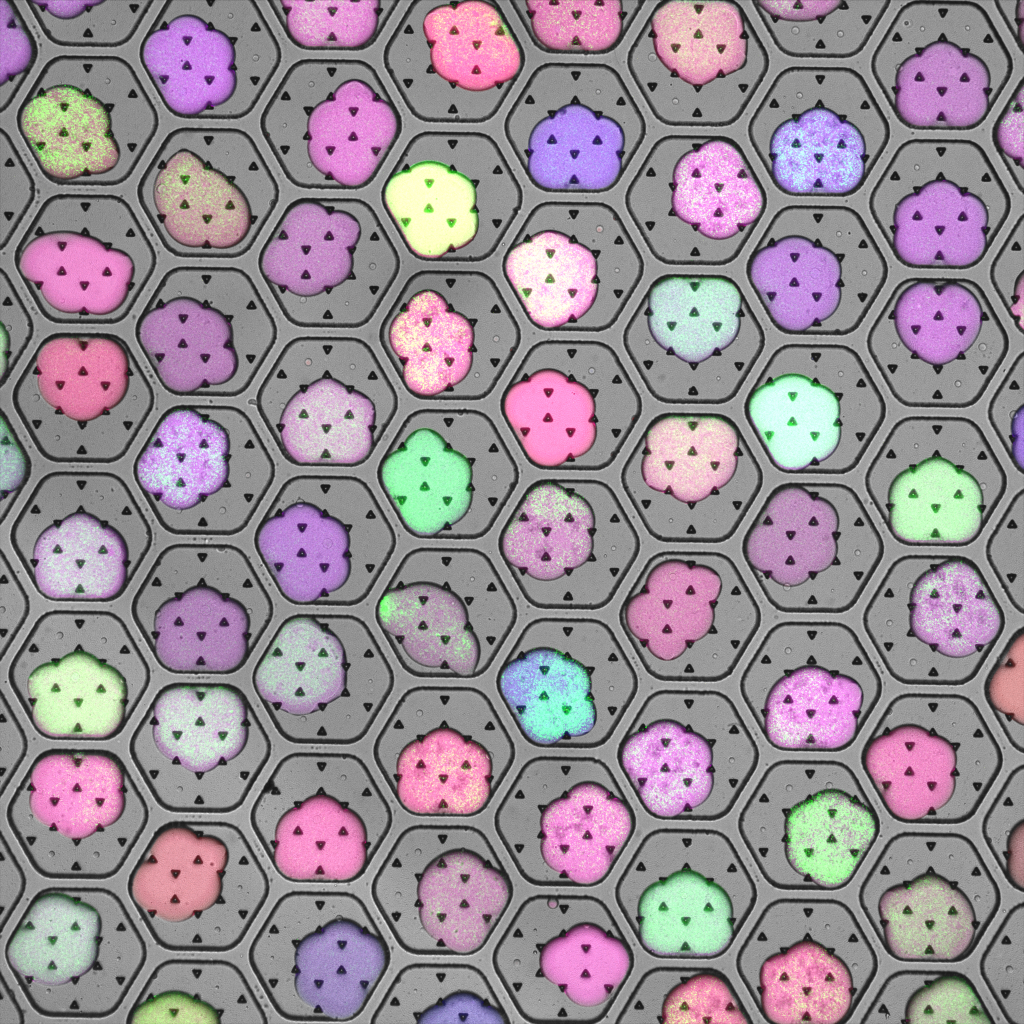
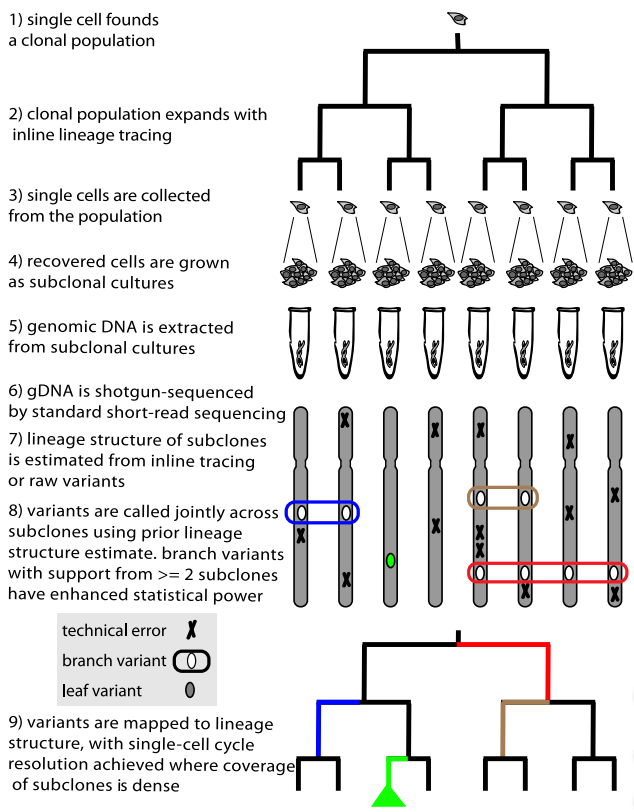
Accurate and sensitive measurement of somatic mutation flow across cells
Genetic changes in somatic cells are important in aging and cancer, yet difficult to detect – even with today’s advanced bulk and single-cell approaches. My group developed a concept to jointly analyze variants across samples related by a lineage prior (rather than one at a time) to improve the sensitivity and specificity of somatic mutation detection and resolve such events in individual related cells. We showed a major improvement in somatic variant calling performance and produced multiple lines of evidence that mutations arise across cells with non-Poissonian statistics and proposed a molecular mechanism by which individual chemical lesions on DNA can strongly couple somatic mutation events in mother and daughter cells.
Publications:
- Brody et al., Quantification of somatic mutation flow across individual cell division events by lineage sequencing (2018), Genome Research.
Robust and accurate systems for single-cell genomics at scale
Single-cell genomics provides an increasingly important window into biology but depends heavily on specialized instrumentation and lacks the cellular throughput needed for many applications. The group developed one method based on a new microfluidics concept we call virtual microfluidics that eliminates the dependence on specialized equipment and a molecular enrichment method that makes a 100-fold improvement in sensitivity/throughput for rare target cells in pooled single-cell RNA-seq libraries.
Publications:
- Xu et al., Virtual microfluidics for digital quantification and single-cell sequencing (2016), Nature Methods.
- Ranu et al., Targeting individual cells by barcode in pooled sequence libraries (2019), Nucleic Acids Research.
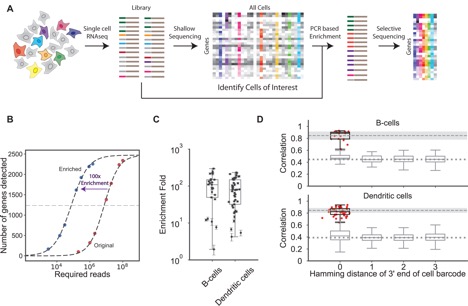
Past Research Areas
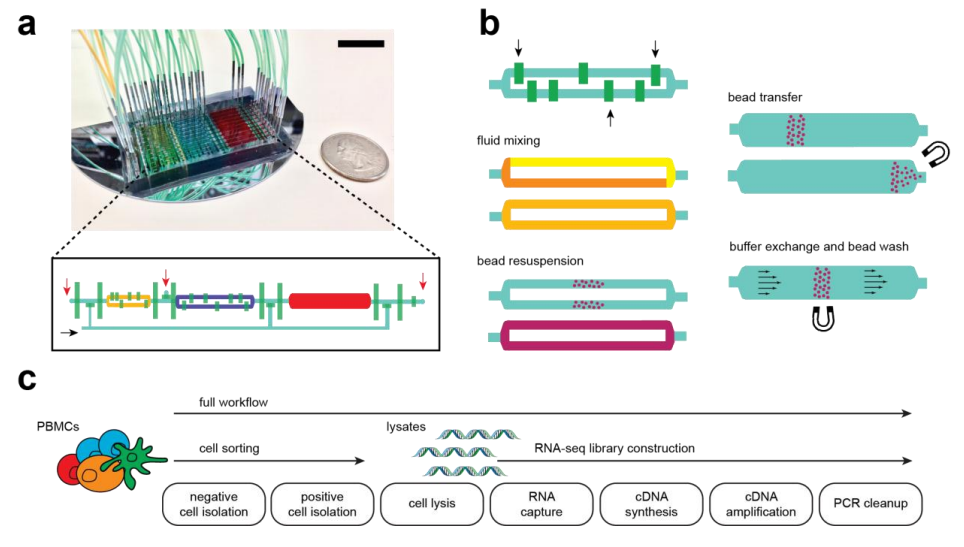
Sample preparation for high-sample-throughput genomic science and medicine
With the ready availability of low-cost sequencing, sample preparation now limits the application of genomics in medicine. We demonstrated automated sample preparation from biomass to sequence libraries at the microscale in lab-on-a-chip systems – addressing total resource demand across labor, capital equipment, and consumables. We also showed how microfluidic workflows maintain quality and require 10-100-fold less sample quantity, enabling new genomic applications in analysis of bacterial pathogens and human primary cells.
Publications:
- Kim et al., High-throughput automated microfluidic sample preparation for accurate microbial genomics (2017), Nature Communications.
- Reyes et al., Multiplexed enrichment and genomic profiling of peripheral blood cells reveal subset-specific immune signatures (2019), Science Advances.
- Reyes et al., Simultaneous profiling of gene expression and chromatin accessibility in single cells (2019), Advanced Biosystems.
Discovery and development of molecular sleds
We applied robust and higher-throughput experimental and analytical methods for the direct analysis of biomolecules sliding and hopping along DNA molecules at the single-molecule level. We discovered sliding activity among short basic peptide molecules and explored the chemical basis of this novel activity. These results implicate thousands of human proteins with likely DNA sliding activity. We also explored the activity of synthetic small molecules, finding that drug-like small molecules can be engineered to slide on DNA.
Publications:
- Mangel et al., Molecular sled is an eleven-amino acid vehicle facilitating biochemical interactions via sliding components along DNA (2016), Nature Communications.
- Xiong et al., Molecular sled sequences are common in mammalian proteins (2016), Nucleic Acids Research.
- Xiong et al., Sliding on DNA: From Peptides to Small Molecules (2016), Angewandte Chemie.
- Xiong and Blainey, A Simple, Robust, and High Throughput Single Molecule Flow Stretching Assay Implementation for Studying Transport of Molecules Along DNA (2017), Journal of Visualized Experiments.
